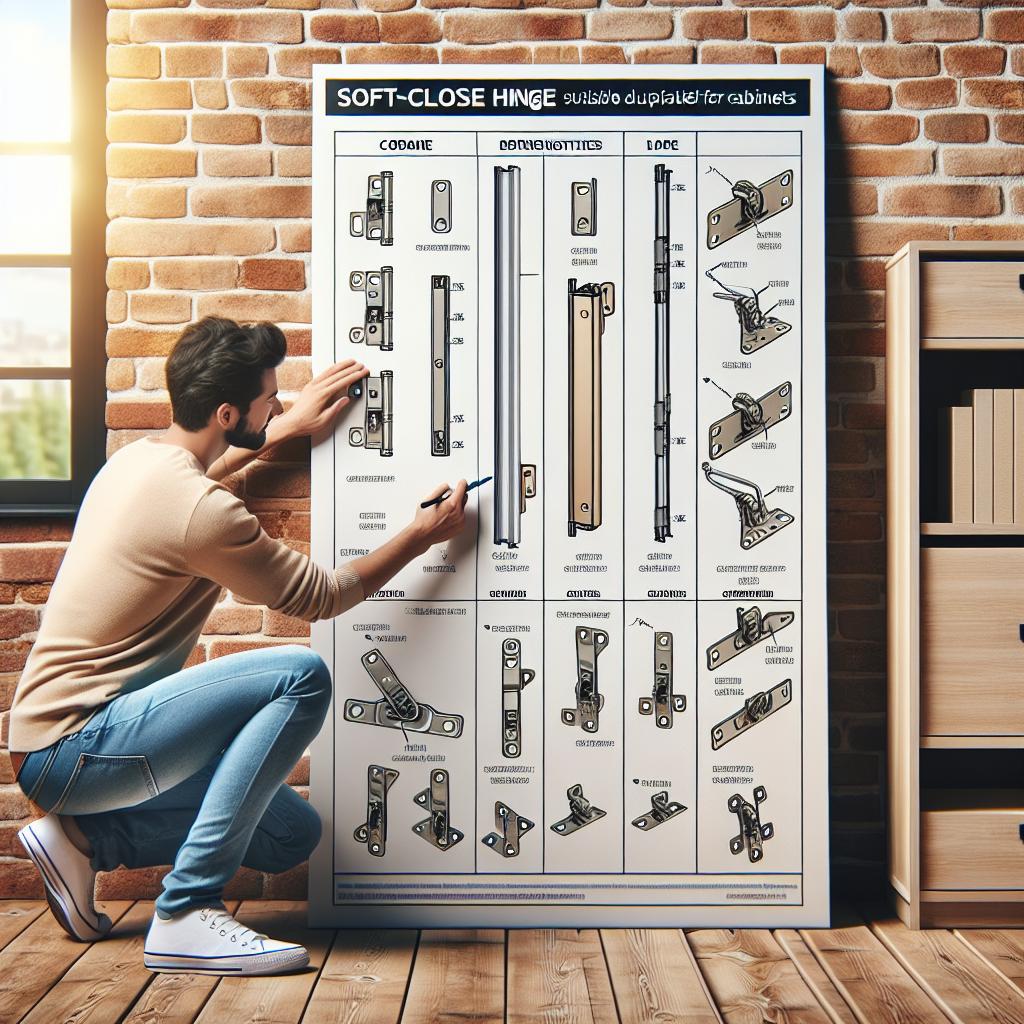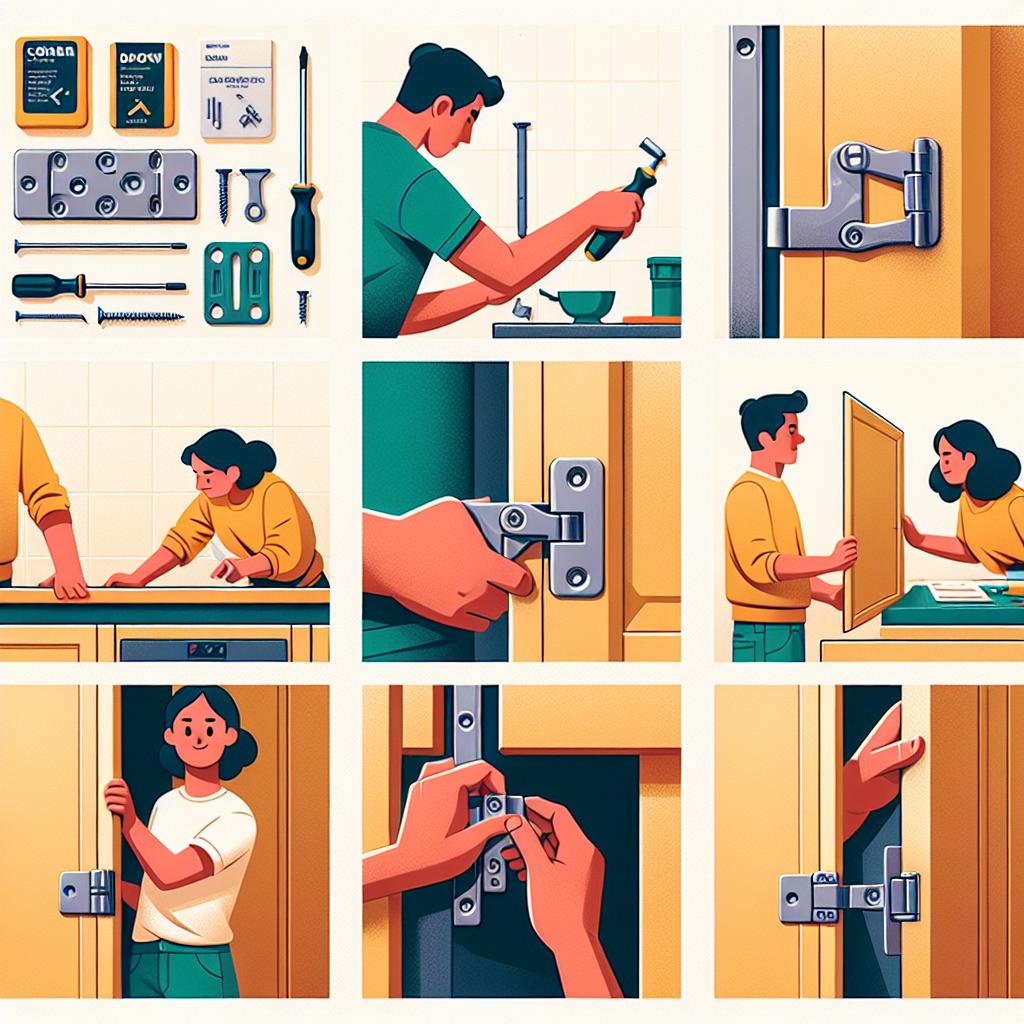Title: The Art of Serenity: Installing Soft-Close Hinges on Cabinets
In the hustle and bustle of daily life, where every moment counts and tranquility is often elusive, even the smallest details in our homes can make a significant difference. Enter the soft-close hinge — a small yet mighty component that transforms the simple act of closing a cabinet door into a symphony of silence. No more jarring slams or unexpected thuds; just smooth, gentle closures that bring a touch of elegance to your kitchen, bathroom, or any cabinetry in your home. In this article, we’ll guide you through the step-by-step process of installing soft-close hinges, offering practical tips and addressing common challenges. Whether you’re a seasoned DIYer or a novice looking to enhance your space, you’ll discover how this straightforward upgrade can elevate the functionality and aesthetic of your cabinetry, all while adding that much-needed touch of serenity to your everyday life.
Understanding Soft-Close Hinges and Their Benefits
Soft-close hinges represent a significant advancement in cabinet hardware, transforming a once-jarring experience into a smooth and gentle closure. This innovative hinge mechanism utilizes advanced dampening technology to control the speed at which a cabinet door closes. The benefits of this feature include:
- Quiet Operation: Enjoy peace and tranquility in your kitchen or living space with cabinets that close quietly.
- Protection Against Damage: Eliminate the risk of slamming, which can lead to wear and tear over time.
- Enhanced Safety: Reduce the likelihood of pinched fingers, making it safer for children and pets.
Moreover, installing soft-close hinges can enhance the overall user experience. They create a sense of luxury and sophistication, making everyday interactions with your cabinets feel more refined. When considering installation, it’s essential to factor in the following aspects:
| Feature | Importance |
|---|---|
| Durability | Ensures long-lasting performance and reliability. |
| Adjustability | Allows fine-tuning for perfect alignment and function. |
| Cost | Varies based on materials and brand but often justifies the quality upgrade. |

Selecting the Right Soft-Close Hinges for Your Cabinets
When it comes to enhancing the functionality and aesthetics of your cabinets, the choice of soft-close hinges plays a crucial role. Consider the following factors to ensure you select the right hinges for your needs:
- Weight Capacity: Make sure the hinges can support the weight of your cabinet doors.
- Material: Opt for durable materials like steel or stainless steel for longevity.
- Size: Measure the dimensions of your doors and ensure the hinges fit properly.
- Style: Choose between concealed or exposed hinges based on your design preferences.
Another important aspect to contemplate is the installation process. Some hinges come with adjustable features that make alignment easy, while others may require specific tools. Here’s a quick comparison of common types:
| Type of Hinge | Easy Installation | Adjustment Features |
|---|---|---|
| Concealed | Yes | 3-way Adjustable |
| Exposed | No | Fixed Position |
| European | Yes | Full Adjustment |

Step-by-Step Guide to Installing Soft-Close Hinges
To kick off the installation of your soft-close hinges, you’ll need to gather a few materials: soft-close hinges, screwdriver, measuring tape, and drill. Begin by removing the existing hinges from your cabinet doors. This typically involves unscrewing the hinges at both the cabinet frame and the door. Take a moment to measure the distance from the top of the cabinet to the current hinge placement to ensure consistency with the new hinges. Once removed, clean the area to ensure a smooth installation. Tip: Mark where the new hinges will go using a pencil to simplify aligning them later.
Next, install the new hinges by aligning them with your marked points, ensuring they are level. Secure the hinges to the door first, followed by attaching them to the cabinet frame. Here’s a quick checklist to confirm a job well done:
- Check that the door opens and closes smoothly.
- Verify that the soft-close mechanism engages properly.
- Ensure that there are no gaps between the door and cabinet.
If you encounter any issues, don’t hesitate to make slight adjustments to the hinge positions—this can make a significant difference in functionality. With everything in place, sit back and enjoy the seamless closure of your newly upgraded cabinets!

Troubleshooting Common Installation Challenges
“`html
Installing soft-close hinges can sometimes be tricky, especially if you’re not familiar with the specifics of the cabinet design. One common issue is misalignment, which can prevent the door from closing properly. To address this, make sure to check the hinge placement before drilling any holes. It’s also beneficial to use a level to ensure your hinges are installed evenly. If the doors still don’t align, you can adjust the screws on the hinges slightly, as most soft-close models come with multiple adjustment options to fine-tune the fit.
Another potential challenge is securing the hinges to the cabinet or door. If the screws keep stripping or the hinges feel loose, consider using a wood filler or dowel in the pre-drilled holes to create a more stable base. Here’s a quick reference table to help you identify the correct screw types for various cabinet materials:
| Cabinet Material | Recommended Screw Type |
|---|---|
| Wood | Wood screws |
| Particleboard | Self-tapping screws |
| Plywood | Wood screws |
| Metal | Machine screws |
“`
Q&A
Q&A: Installing Soft-Close Hinges on Cabinets
Q: What are soft-close hinges, and why should I consider them for my cabinets?
A: Soft-close hinges are a type of hinge designed to allow cabinet doors to close quietly and gently. They are engineered with a damping mechanism that slows down the door as it nears the cabinet frame, preventing loud slams and reducing wear on both the hinge and the cabinet itself. Installing them enhances the longevity of your furniture and adds an element of luxury to your kitchen or bathroom.
Q: What tools will I need to install soft-close hinges on my cabinets?
A: You’ll need a few basic tools to get started: a screwdriver (preferably a power drill for efficiency), a measuring tape for accuracy, a level to ensure straight installation, and possibly a chisel for mortising if your cabinets require it. Having a pencil for marking positions will also come in handy.
Q: Is it difficult to replace standard hinges with soft-close hinges?
A: The complexity can vary depending on your experience and the existing cabinet setup. However, replacing standard hinges with soft-close hinges is generally a straightforward task, especially if the new hinges are designed for easy installation. Most kits come with step-by-step instructions, making the process accessible for DIY enthusiasts of all skill levels.
Q: Can I install soft-close hinges on any type of cabinet?
A: Soft-close hinges can be installed on most full overlay, partial overlay, and inset cabinets, as long as you choose the right type of hinge for your cabinet design. It’s essential to measure your cabinet doors and assess the existing hinge placement to ensure compatibility.
Q: How do I determine the right size and type of soft-close hinge for my cabinets?
A: The right size hinge is typically determined by measuring the dimensions of your cabinet doors and the hinge plate’s footprint. For type, consider factors like how the cabinet doors open (overlay or inset) and whether you want the hinges to be concealed once installed. Most hardware stores have knowledgeable staff who can help guide you in finding the correct specifics.
Q: Are there any particular brands or models of soft-close hinges that you recommend?
A: While personal preference plays a significant role, popular brands such as Blum, Hettich, and Amerock consistently receive positive reviews for their durability and smooth performance. Before purchasing, check for warranty coverage and customer feedback as well to ensure you’re getting a trusted product.
Q: What are some common installation mistakes I should watch out for?
A: One common pitfall is misalignment, which can lead to uneven door gaps and difficulty in closing. Ensure you measure carefully and double-check your markings before drilling. Additionally, not securing the hinges tightly can affect performance, so use screws appropriately. Lastly, forgetting to test the closure before finalizing the installation can result in last-minute adjustments.
Q: How can I maintain my soft-close hinges for optimal performance?
A: Soft-close hinges are generally low-maintenance, but regular inspections are beneficial. Check for any loose screws and tighten them as needed. Periodically clean any dust or debris from the hinge area, as buildup can affect functionality. If the damping mechanism becomes sluggish over time, consult the manufacturer’s recommendations for any adjustments or lubrication.
Q: Can I add soft-close functionality to cabinets that don’t currently have it?
A: Absolutely! Installing soft-close hinges is a fantastic upgrade for older cabinets that lack this feature. Just ensure you remove the existing hinges carefully and follow the installation instructions for your new soft-close hardware. This upgrade can dramatically improve your cabinetry experience without requiring a complete remodel.
Whether you’re a DIY novice or a seasoned pro, installing soft-close hinges can be a fulfilling project that adds a touch of elegance and functionality to your home. Happy installing!
To Conclude
As we close the door on our exploration of installing soft-close hinges, it becomes clear that this simple upgrade can transform your cabinets into a realm of quiet elegance. With just a few tools and a bit of patience, you can enhance your kitchen or bathroom experience, balancing functionality with a touch of luxury. Not only do soft-close hinges protect your cabinetry from wear and tear, but they also infuse your space with a calm, polished ambiance. So whether you’re embarking on a DIY project or collaborating with a professional, remember: every little detail counts. Embrace the art of subtle innovation, and enjoy the smooth, serene satisfaction each gentle close brings. Happy renovating!

